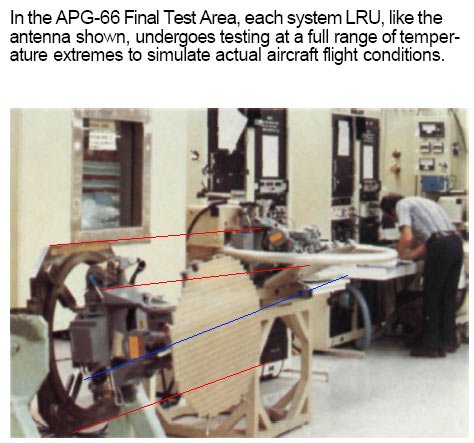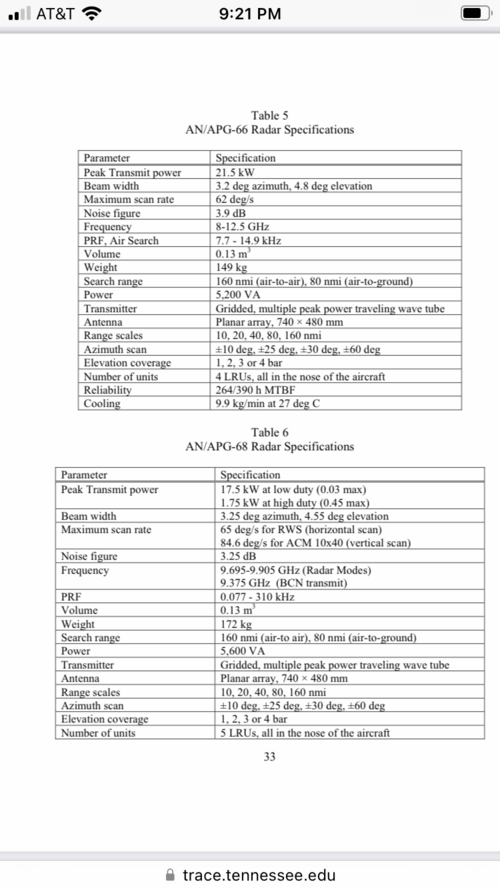You are using an out of date browser. It may not display this or other websites correctly.
You should upgrade or use an alternative browser.
You should upgrade or use an alternative browser.
F-16 Avionics, Westinghouse AN/APG-66, AN-APG-68 radars
- Thread starter Pit
- Start date
Russian speakers would enjoy a lot with the following russian page about the AN/APG-66. Its a russian translation of a LONG and EXTREMLY detailed analysis of AN/APG-66 published bak then in the 80s by the IEEE.
I will made an english translation for those that didn't talk russian and attach it here as a word document...worth checking!.
Source -
http://forums.airbase.ru/index.php?showtopic=10739
I will made an english translation for those that didn't talk russian and attach it here as a word document...worth checking!.
Source -
http://forums.airbase.ru/index.php?showtopic=10739
Stealth Spy
ACCESS: Restricted
- Joined
- 13 February 2006
- Messages
- 3
- Reaction score
- 0
Block-60's radar and systems :
> Northrop Grumman AN/APG-80 "Agile Beam Radar" AESA radar
> Northrop Grumman AN/ASQ-28 IFTS (Internal FLIR and Targeting System)
> F110-GE-132 turbofan, rated 32,500 lbs thrust
> New Modular mission computer has a processing throughput of 12.5 million instructions per second and provides sensor and weapons integration.
> ALQ-165 electronic countermeasures system, also known as the Airborne Self-Protection Jammer (ASPJ)
> New electronic warfare management system
> Fiber-optic avionics data bus
> Up to eight chaff/flare dispensers,
> New advanced friend or foe detection system
> New pilot-aircraft interface by incorporating three advanced 5-inch by 5-inch color displays.
+ Its range is extended with addition of fuselage mounted conformal fuel tanks and wing tanks.
New developments ... M4.2+ swing role suite
> Northrop Grumman AN/APG-80 "Agile Beam Radar" AESA radar
> Northrop Grumman AN/ASQ-28 IFTS (Internal FLIR and Targeting System)
> F110-GE-132 turbofan, rated 32,500 lbs thrust
> New Modular mission computer has a processing throughput of 12.5 million instructions per second and provides sensor and weapons integration.
> ALQ-165 electronic countermeasures system, also known as the Airborne Self-Protection Jammer (ASPJ)
> New electronic warfare management system
> Fiber-optic avionics data bus
> Up to eight chaff/flare dispensers,
> New advanced friend or foe detection system
> New pilot-aircraft interface by incorporating three advanced 5-inch by 5-inch color displays.
+ Its range is extended with addition of fuselage mounted conformal fuel tanks and wing tanks.
New developments ... M4.2+ swing role suite
http://www.af.mil/news/story.asp?storyID=123011241The F-16 is a compact, multirole fighter aircraft designed to be highly maneuverable in air-to-air combat and air-to-surface attack. There are several versions of the F-16 used by the United States, including the Block 40 and Block 50.
The Block 40 F-16 primary mission fills the air-to-surface attack role, while the Block 50’s primary mission is destruction and suppression of enemy air defenses.
The M4.2-plus avionics upgrade combines both combat roles into a single fighter aircraft. The upgrade is being completed using spiral development, meaning all program stakeholders, including developmental testers, contractors and operational units work together early in the process to ensure testing is conducted more efficiently. This helps align operational objectives and is geared toward providing mature, stable systems to the warfighter as quickly as possible.
"The M4.2-plus upgrade achieves the goal of the Air Force's F-16 Common Configuration Implementation Program to support common aircraft equipment and core avionics software capabilities," said Shauna Urwiller, Global Power Fighters program manager from the 416th FLTS.
- Joined
- 27 December 2005
- Messages
- 16,914
- Reaction score
- 21,737
Vadifon
ACCESS: Restricted
- Joined
- 27 December 2005
- Messages
- 16,914
- Reaction score
- 21,737
Do you have the product or brochure for these data ?Block-60's radar and systems :
> Northrop Grumman AN/APG-80 "Agile Beam Radar" AESA radar
> Northrop Grumman AN/ASQ-28 IFTS (Internal FLIR and Targeting System)
> F110-GE-132 turbofan, rated 32,500 lbs thrust
> New Modular mission computer has a processing throughput of 12.5 million instructions per second and provides sensor and weapons integration.
> ALQ-165 electronic countermeasures system, also known as the Airborne Self-Protection Jammer (ASPJ)
> New electronic warfare management system
> Fiber-optic avionics data bus
> Up to eight chaff/flare dispensers,
> New advanced friend or foe detection system
> New pilot-aircraft interface by incorporating three advanced 5-inch by 5-inch color displays.
+ Its range is extended with addition of fuselage mounted conformal fuel tanks and wing tanks.
Or do you know where this information originally came from?
- Joined
- 18 May 2019
- Messages
- 640
- Reaction score
- 1,638
AFTI/F-16 AUTOMATED MANEUVERING ATTACK SYSTEM TEST REPORTS/SPECIAL TECHNOLOGIES AND OUTLOOK
https://apps.dtic.mil/dtic/tr/fulltext/u2/a184941.pdf
- Joined
- 11 February 2007
- Messages
- 2,089
- Reaction score
- 3,082
AFTI/F-16 AUTOMATED MANEUVERING ATTACK SYSTEM TEST REPORTS/SPECIAL TECHNOLOGIES AND OUTLOOK
https://apps.dtic.mil/dtic/tr/fulltext/u2/a184941.pdf
"The final Phase A OFP completely filled the 32K of allocated memory. "
" The HUD OFP resides in 16K of EPROM memory. "
Ah, the good old days.

Northrop will provide F-16 electronic warfare system
The project's goal is to protect pilots from increasing radio frequency-guided weapons.
Last edited:
Taiwan F-16 Block 20 to get GCAS (and more) :

 defence-blog.com
defence-blog.com
Lockheed Martin Aeronautics Corp. was awarded a $138 million contract modification for the development and fielding of capabilities for the Automatic Ground Collision Avoidance System and AGM-88 High Speed Anti-radiation Missile; improvements in radar software maturity; an update to the Data Acquisition System; and Advanced Identification Friend or Foe for the Taiwan Retrofit Program F-16 Block 20 fleet, the Department of Defense announced.

Lockheed Martin to provide Taiwanese Air Force with improved AGM-88 missiles
The U.S. Department of Defense had announced the contract, a modification to a previous award, for Peace Phoenix Rising 2 (PPR2) program of the Taiwanese Air Force, also known as the Republic of China Air Force (ROCAF). Lockheed Martin Aeronautics Corp. was awarded a $138 million contract...
F-2
ACCESS: Top Secret
- Joined
- 22 May 2020
- Messages
- 776
- Reaction score
- 1,483
Apg-66 1983 performance report

 www.scribd.com
www.scribd.com
F-16 Pulse Doppler Radar (AN/APG-66) Performance-1983 | PDF | Radar | Microwave Technology
Performance of AN/APG-66 radar. based on extensive flight test conducted in 1977-1980.
jsport
what do you know about surfing Major? you're from-
- Joined
- 27 July 2011
- Messages
- 7,099
- Reaction score
- 4,822

Northrop will provide F-16 electronic warfare system
The project's goal is to protect pilots from increasing radio frequency-guided weapons.www.c4isrnet.com

USAF Tests 'Angry Kitten' Electronic Warfare Pod on F-16
The US Air Force recently tested its “Angry Kitten” electronic countermeasures training pod on an F-16 aircraft.
 www.thedefensepost.com
www.thedefensepost.com
LukaszK
I really should change my personal text
- Joined
- 15 January 2018
- Messages
- 64
- Reaction score
- 80
Technical documentation regarding APG-66
https://apps.dtic.mil/sti/pdfs/ADA142075.pdf
https://apps.dtic.mil/sti/pdfs/ADA142075.pdf
F-2
ACCESS: Top Secret
- Joined
- 22 May 2020
- Messages
- 776
- Reaction score
- 1,483
I don’t know if anybody has these articles but they seem to discuss the PESA that was planned for the block 50/52.


Interavia
books.google.com
A Collection of Technical Papers
books.google.com
- Joined
- 27 December 2005
- Messages
- 16,914
- Reaction score
- 21,737
Updated post with missing brochure.Here is a Westinghouse brochure for the AN/APG-66. Contains a lot of useful information.
- Joined
- 27 December 2005
- Messages
- 16,914
- Reaction score
- 21,737
And this one too.Westinghouse APG-68 brochure. Again some nice info + pics.
“(With the F-16’s previous APG-68 fire control radar), I had the ability to target up to two tracks, that’s it,” said Lt. Col. Michael Trujillo, District of Columbia ANG’s 113th Aerospace Control Alert Detachment commander, the unit responsible for the air defense of the national capital region. “At that point, my radar is completely saturated and has no more bandwidth. With the AESA radar, (without getting into) specific numbers, I can target more things than I can shoot.”
(snip)
"... Emerging threats are among the biggest reasons for provisioning the AESA radar. The F-16’s previous APG-68 fire control radar had near-zero capability against cruise missiles, which means the AESA radar provides new capabilities for the legacy aircraft, explained Trujillo. "
https://www.af.mil/News/Article-Dis...unches-f-16-into-next-generation-of-airpower/
(snip)
"... Emerging threats are among the biggest reasons for provisioning the AESA radar. The F-16’s previous APG-68 fire control radar had near-zero capability against cruise missiles, which means the AESA radar provides new capabilities for the legacy aircraft, explained Trujillo. "
https://www.af.mil/News/Article-Dis...unches-f-16-into-next-generation-of-airpower/
- Joined
- 27 December 2005
- Messages
- 16,914
- Reaction score
- 21,737
Interesting, given that the Zaslon radar was intended to locate cruise missiles and designed in the early 1970s. Pretty sure AN/APG-63 could give it a go too."... Emerging threats are among the biggest reasons for provisioning the AESA radar. The F-16’s previous APG-68 fire control radar had near-zero capability against cruise missiles, which means the AESA radar provides new capabilities for the legacy aircraft, explained Trujillo. "
https://www.af.mil/News/Article-Dis...unches-f-16-into-next-generation-of-airpower/
F-2
ACCESS: Top Secret
- Joined
- 22 May 2020
- Messages
- 776
- Reaction score
- 1,483
APG-63(v)2 was built exclusively with the anti cruise missile mission in mind. Which makes me think the original and msip radar was unable to effectively do so.Interesting, given that the Zaslon radar was intended to locate cruise missiles and designed in the early 1970s. Pretty sure AN/APG-63 could give it a go too."... Emerging threats are among the biggest reasons for provisioning the AESA radar. The F-16’s previous APG-68 fire control radar had near-zero capability against cruise missiles, which means the AESA radar provides new capabilities for the legacy aircraft, explained Trujillo. "
https://www.af.mil/News/Article-Dis...unches-f-16-into-next-generation-of-airpower/
Interesting, given that the Zaslon radar was intended to locate cruise missiles and designed in the early 1970s. Pretty sure AN/APG-63 could give it a go too."... Emerging threats are among the biggest reasons for provisioning the AESA radar. The F-16’s previous APG-68 fire control radar had near-zero capability against cruise missiles, which means the AESA radar provides new capabilities for the legacy aircraft, explained Trujillo. "
https://www.af.mil/News/Article-Dis...unches-f-16-into-next-generation-of-airpower/
A 1985 report by the CIA and two 1978 AW&ST stories mention the MiG-31's capability against cruise missiles, but there is no mention about the target's RCS.
https://www.cia.gov/readingroom/docs/DOC_0000261292.pdf
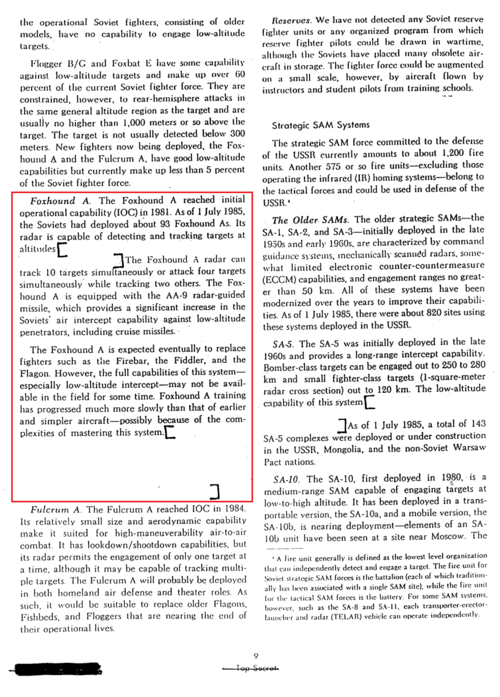
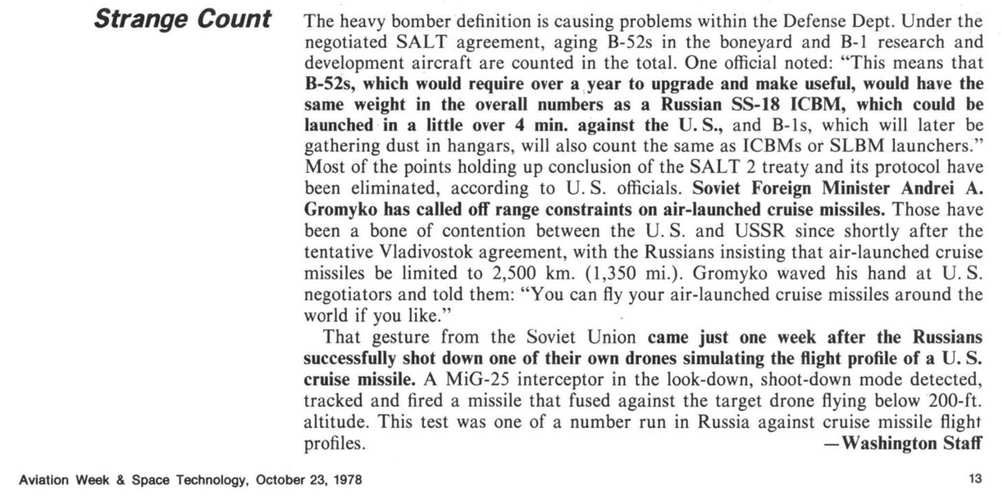
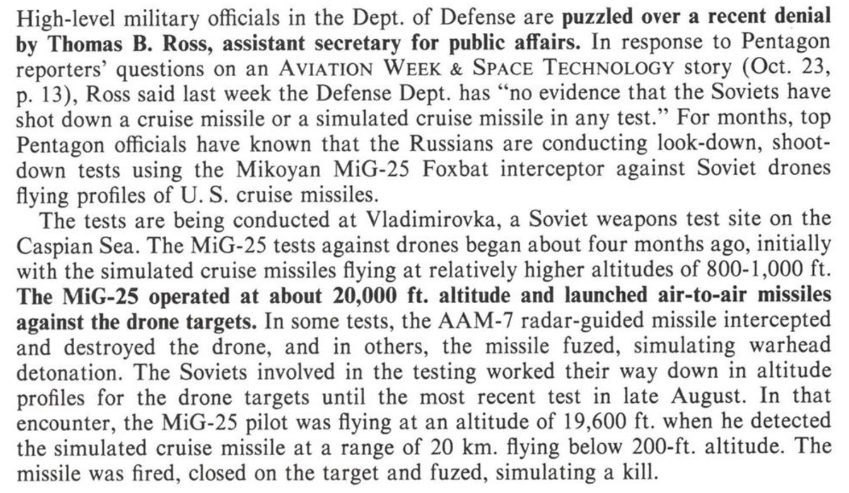
- Joined
- 27 December 2005
- Messages
- 16,914
- Reaction score
- 21,737
Zaslon would have advantages from electronic scanning against cruise missile targets.
F-2
ACCESS: Top Secret
- Joined
- 22 May 2020
- Messages
- 776
- Reaction score
- 1,483
So I just remembered Japan developed AAM-4 with anticruise missile being the primary mission and it went live on the mechanical scan APG-63(v)1 so now I’m not sure. They shot down ASM-2 missiles in testing. So honestly I’m not sure.
F-2
ACCESS: Top Secret
- Joined
- 22 May 2020
- Messages
- 776
- Reaction score
- 1,483
F-16IN (enhanced Block 60) simulator
F-2
ACCESS: Top Secret
- Joined
- 22 May 2020
- Messages
- 776
- Reaction score
- 1,483
Thought this was interesting
Attachments
F-2
ACCESS: Top Secret
- Joined
- 22 May 2020
- Messages
- 776
- Reaction score
- 1,483
English version of above paperRussian speakers would enjoy a lot with the following russian page about the AN/APG-66. Its a russian translation of a LONG and EXTREMLY detailed analysis of AN/APG-66 published bak then in the 80s by the IEEE.
I will made an english translation for those that didn't talk russian and attach it here as a word document...worth checking!.
Source -

РЛС AN/APG-66 со средней частотой повторения импульсов [Форумы Balancer.Ru]
РЛС AN/APG-66 со средней частотой повторения импульсов У.X.ЛОНГ III,член ИИЭР; К.Э.ХАРРИГЕР, старший член ИИЭР Рассматривается применение режима средних частот повторения импульсов (СЧП) в…forums.airbase.ru
Attachments
Thank youEnglish version of above paperRussian speakers would enjoy a lot with the following russian page about the AN/APG-66. Its a russian translation of a LONG and EXTREMLY detailed analysis of AN/APG-66 published bak then in the 80s by the IEEE.
I will made an english translation for those that didn't talk russian and attach it here as a word document...worth checking!.
Source -

РЛС AN/APG-66 со средней частотой повторения импульсов [Форумы Balancer.Ru]
РЛС AN/APG-66 со средней частотой повторения импульсов У.X.ЛОНГ III,член ИИЭР; К.Э.ХАРРИГЕР, старший член ИИЭР Рассматривается применение режима средних частот повторения импульсов (СЧП) в…forums.airbase.ru
F-2
ACCESS: Top Secret
- Joined
- 22 May 2020
- Messages
- 776
- Reaction score
- 1,483
Kuchinski 1984 | PDF | Radar | General Dynamics F 16 Fighting Falcon
Scribd is the world's largest social reading and publishing site.
A paper on the APG-66 family of radars from 1984
F-2
ACCESS: Top Secret
- Joined
- 22 May 2020
- Messages
- 776
- Reaction score
- 1,483

APG-68(V)9火控雷达的飞行试验
m.doc88.com
Chinese translation of society of experimental test pilots paper on apg-68(v)9. Recommend google lense.
I have a question to the experts. Which versions of the F-16 had the on-board long-range High Frequency radios like the AN/ARC-190 or the more contemporary sets like the AN/ARC-200 (or later)? As an example, the photo from the link below allegedly shows the cockpit of a Polish AF F-16C with an unknown type of the digital HF radio control panel on the right hand console.


Aircraft » Dęblin » Lockheed Martin F-16C Fighting Falcon, 561, Polish Air Force - cockpit - Marcin 'Rambo' Roguski - photo gallery
Image 'Lockheed Martin F-16C Fighting Falcon, 561, Polish Air Force - cockpit' in gallery 'Dęblin'
marcin-roguski.info
LukaszK
I really should change my personal text
- Joined
- 15 January 2018
- Messages
- 64
- Reaction score
- 80
According to the image ... well this seems to be F-16A ..look for its displays ... Maybe it is some "educational" plane ... as Deblin is "school" for pilots... for sure not to fly on it...I have a question to the experts. Which versions of the F-16 had the on-board long-range High Frequency radios like the AN/ARC-190 or the more contemporary sets like the AN/ARC-200 (or later)? As an example, the photo from the link below allegedly shows the cockpit of a Polish AF F-16C with an unknown type of the digital HF radio control panel on the right hand console.

Aircraft » Dęblin » Lockheed Martin F-16C Fighting Falcon, 561, Polish Air Force - cockpit - Marcin 'Rambo' Roguski - photo gallery
Image 'Lockheed Martin F-16C Fighting Falcon, 561, Polish Air Force - cockpit' in gallery 'Dęblin'marcin-roguski.info
Edit:
https://dlapilota.pl/wiadomosci/polska/deblin-nowy-samolot-nowe-mozliwosci (just translate)
Last edited:
Thanks for the reply. I agree that it was rather an F-16A's cockpit due to the single monochrome display in the center console and the alphanumeric LED display on the left side of the instrument panel. Still, the HF radio issue is unresolved. Didn't know that the F-16A Block 15 were fitted with HF sets.
Scorpion82
ACCESS: Confidential
- Joined
- 20 May 2006
- Messages
- 143
- Reaction score
- 218
Thanks for the reply. I agree that it was rather an F-16A's cockpit due to the single monochrome display in the center console and the alphanumeric LED display on the left side of the instrument panel. Still, the HF radio issue is unresolved. Didn't know that the F-16A Block 15 were fitted with HF sets.
Block 15ADF were.
I have a question to the experts. There are indications that the F-16AD (Block 15 ADF) received the CW illumination capability for the AIM-7 Sparrow guidance. Were the Sparrows ever fitted to these ADF variants, or did these birds usually patrol with the AIM-120 and AIM-9?
Scorpion82
ACCESS: Confidential
- Joined
- 20 May 2006
- Messages
- 143
- Reaction score
- 218
They were fitted, but replaced by AMRAAM when it became available in the early 1990s.
Similar threads
-
McDonnell-Douglas F-15 Avionics, AN/APG-63/70 radar
- Started by overscan (PaulMM)
- Replies: 95
-
-
-
AWG-10 WCS and APG-59 Radar
- Started by overscan (PaulMM)
- Replies: 87
-

